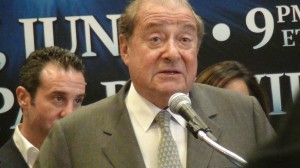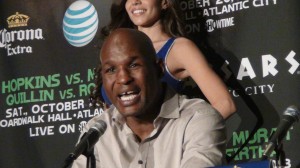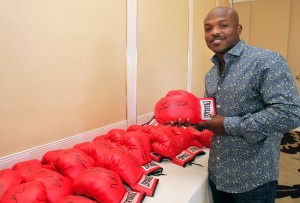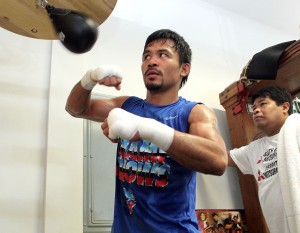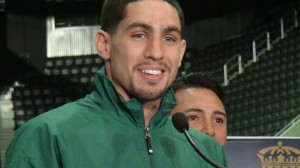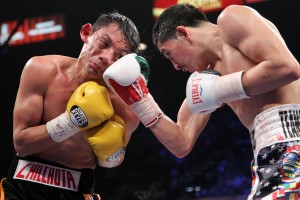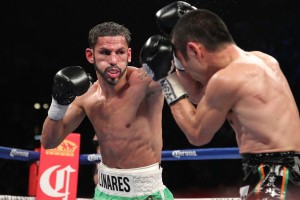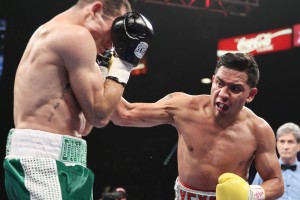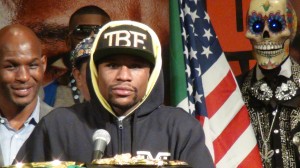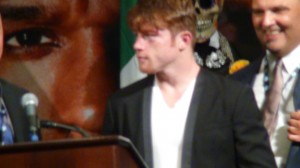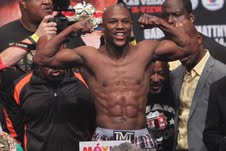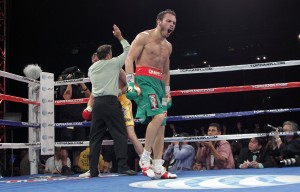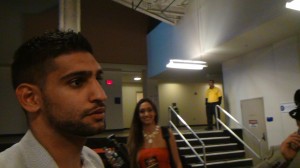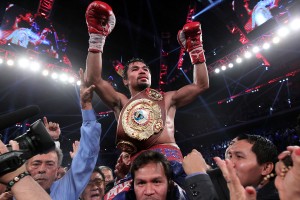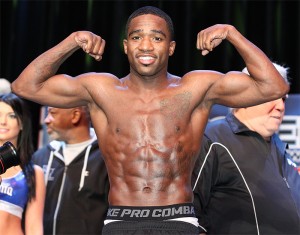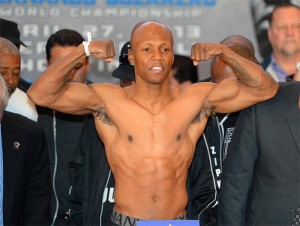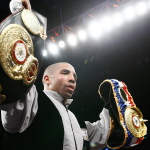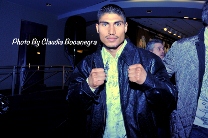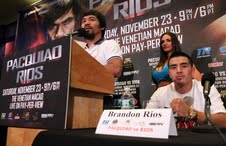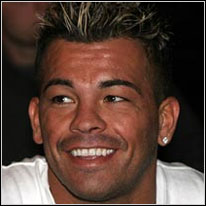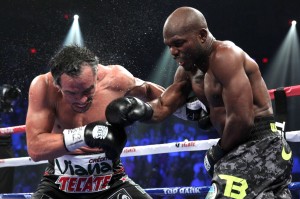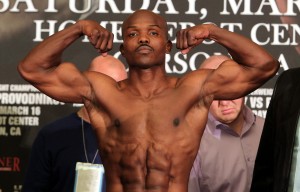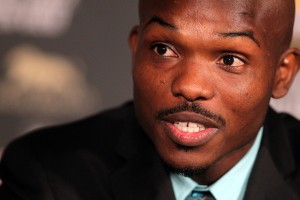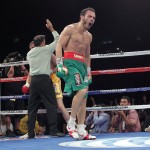
SAN ANTONIO – Adrien Broner calls himself The Problem because he thought he’d never have one. Marcos Maidana proved just how wrong he was.
Maidana was his problem, again and again, throughout 12 surprising rounds Saturday night at the Alamodome. In the end, Broner was left with multiple problems. But let’s start with the biggie. Broner, a big betting favorite, lost for the first time.
But, it turns out, Broner had an edge in only flamboyance. All of the other advantages belonged to Maidana. The Argentine’s power, resilience and nasty grit were just too much for Broner, who entered the ring with About Billions spelled out in gold sequins on the back of his robe and trunks. He left looking like a broken man. There were no billions in his loss to Maidana. There wasn’t even a single scorecard in his favor.
The judges were unanimous for Maidana. Laurence Cole scored it 117-109, Nelson Vazquez had it 116-109 and Stanley Christodoulou 116-110, all for the heavy-handed Argentine.
Maidana re-defined those AB initials on the front of Broner’s robe. They could have meant Approaching Bankruptcy in this stunning bout, Broner’s second and perhaps last attempt at welterweight.
“I showed I had a lot of heart,’’ Maidana said.
Actually, Maidana showed a lot more than that. He fought with urgency, almost as if he knew this was his career’s last chance in an arena named for a one history’s famous last stands. Maidana (35-3, 31 KOs) made an immediate statement, stunning Broner (27-1, 22 KOs) with a left hook against the ropes.
That left hand punctuated the fight early, midway and in the end. It knocked down Broner in the second and again in the eighth. It was always there, slowing down Broner just as though it looked as if he were about to dictate the pace and perhaps the result. Broner raced to his dressing room without facing the media. His only quote came through a spokesperson. He asked for another chance.
“I’ll tell you one thing, I want a rematch,’’ Broner said through the spokesperson. “I don’t want a warm-up fight. I want a rematch.’’
Maidana had no problem with that request.
“Sure, I’ll do a rematch,’’ said Maidana, who never seemed bothered by the power shots thrown by Broner, a former lightweight and maybe a future one.
Maidana spoke with confidence that he could repeat a victory that included some rough moments. In the eighth, Maidana was penalized one point after dropping Broner to his knees. The penalty was for an infraction that looked to be an elbow and/or head butt to Broner’s chin. It left Broner rolling around in the canvas in apparent pain. There was also a look of anguish, if not self-doubt. It almost appeared that Broner wondered what he had gotten himself in to.
“It was a dirty fight,’’ Maidana said. “I had to get dirty.’’
He had to be The Real Problem.
The Best of the Undercard
· Florida welterweight Keith Thurman calls himself One Time. It’s etched across the belt of his trunks. It’s supposed to be a promise. It’s what he intends to do to the other guy. One time early in the first round, however, it almost happened to Thurman (22-0, 19 KOs). Jesus Soto Karass (28-9-3, 18 KOs), Antonio Margarito’s old sparring partner, hurt him with a winging right. Thurman was quick to recover, landed a left for a knockdown in the sixth and went on to win by a wicked stoppage at 2:21 of the ninth. Soto Karass dropped his hands after he was rocked by a left from Thurman, who followed with three successive punches – two lefts and a right.
· If there’s a sure sign of Leo Santa Cruz’ imminent stardom, it’s in the margins. It’s not if he wins. It’s how. Santa Cruz (26-0-1, 15 KOs) wasn’t happy with his unanimous decision over Puerto Rican Cesar Seda (25-2, 17 KOs). “I wanted to give the fans of San Antonio a better fight,’’ said the Los Angeles super-bantamweight, who retained his acronym-sanctioned version of the title. In the fifth, Santa Cruz knocked down Seda, who argued that he was robbed. But even the knockdown wasn’t enough for Santa Cruz, his own worst critic and a good bet to improve.
· Beibut Shumenov looks awkward. Looks slow. But don’t let looks fool you. His power is real. Shumenov 14-1, 9 KOs), another Kazakhstani with a big punch, knocked down Tamas Kovacs (23-1, 14 KOs) once in the first round, again in the second and finished the Slovakian by TKO at 2:55 of the third. In his first fight in a year-and-a-half, Shumenov kept his acronym-sanctioned light-heavyweight belt and maybe moved to the front of the line as a possible challenger to Bernard Hopkins, who watched from a ringside seat.
The Controversial
Former super-middleweight champion Jermain Taylor was off TV. Some thought he should been off the card, too. But he wasn’t. Taylor was licensed to fight in his second comeback since suffering a reported brain bleed in a loss to Arthur Abraham in 2009. Taylor (32-4-1, 20 KOs) was never in danger in this one, scoring a fifth-round knockdown en route to a seventh-round TKO of faded J.C. Candelo (32-13-4, 21 KOs) of Houston.
The Rest
· Junior-welterweight Ricardo Alvarez (28-4, 20 KOs) has none of his brother’s red hair, but some of his luck. Alvarez, Canelo’s brother, got a 10-round majority decision – a controversial one, too – over Rod Salka (18-3, 3 KOs) of Bunola, PA.
· In a television opener, Toledo lightweight Robert Easter Jr. (8-0, 8 KOs) scored a first-round knockout by dropping Chilean Hardy Paredes (16-13, 10 KOs) with a paralyzing body shot 2:30 after the opening bell.
· Three-time Olympian Rau’Shee Warren stayed unbeaten as a pro bantamweight with an 8-round, unanimous decision over Mexican Jose Silveria (15-10, 6 KOs). But there’s some discrepancy about Warren’s record. The official program and FightFax listed him at 16-0 with three KOs before opening bell. According to BoxRec, he’s now 9-0, his record since his final amateur bout at the 2012 London Games.
· In a swing bout, lightweight Jamel Herring (6-0, 3 KOs) of Coram, N.Y., probably left Showtime producers scrambling to fill some air time. Herring made making quick work out of Lance Williams (6-3, 6 KOs) of Muscatine, Iowa, scoring a second round TKO in the final second of the second round.
